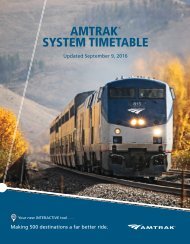Queens
northeast_queens_bus_study_-_final_9-28-15
northeast_queens_bus_study_-_final_9-28-15
Create successful ePaper yourself
Turn your PDF publications into a flip-book with our unique Google optimized e-Paper software.
, Metropolitan Transportation Authority<br />
Loading Guidelines for Local Bus<br />
Loading guidelines vary across route type, time of day/week and bus size. Guidelines outline the most<br />
common service intervals (headways) for standard and articulated buses, grid and feeder routes, and for<br />
peak periods, off‐ peak periods (includes middays, early evenings, and weekends), and late evening.<br />
During overnight periods, service frequency will generally be governed by the schedule guideline’s<br />
minimum frequency of 60 minutes.<br />
Average Peak Load<br />
Peak load is the number of passengers on a bus at its busiest point. MTA loading guidelines do not refer<br />
to individual buses. These guidelines refer to the peak number of passengers on a specific route, averaged<br />
over a given period of time (½ hour during the peak, one hour during off‐peak).<br />
Route Type<br />
Routes are characterized as grid or feeder service. Grid routes constitute most local bus routes. Grid<br />
routes operate through multiple neighborhoods with customers boarding and alighting throughout the<br />
length of the route. Feeder routes primarily carry customers from outlying areas to a subway station or<br />
major terminal, with most customers having a common origin or destination. Feeder routes are permitted<br />
to carry more customers per bus because there is less need for internal circulation due to the common<br />
origin or destination.<br />
Feeder routes in Northeast <strong>Queens</strong> include the Q1, Q13, Q15, Q15A, Q16, Q26, Q28, Q36, and Q64.<br />
Frequency of Service<br />
During peak hours, most bus service is scheduled so that all seats can be filled and some passengers will<br />
be standing at the route’s busiest point, i.e., the number of passengers exceeds the number of seats when<br />
the bus is most crowded. For example, the MTA will not add buses to a peak‐period grid route with 5‐<br />
minute headways until a 40‐seat bus has more than 54 peak‐point riders, on average. As bus frequency<br />
decreases, the allowable average peak load also decreases.<br />
Table 39. Current Loading Levels Compared to Loading Guidelines (NYCT Routes Only)<br />
Weekday Saturday Sunday<br />
Route<br />
AM<br />
Peak<br />
Hour<br />
Mid<br />
(1pm‐<br />
2pm)<br />
PM<br />
Peak<br />
Hour<br />
Eve<br />
(8pm‐<br />
9pm)<br />
AM<br />
Peak<br />
Hour<br />
Mid<br />
(1pm‐<br />
2pm)<br />
PM<br />
Peak<br />
Hour<br />
Eve<br />
(8pm‐<br />
9pm)<br />
AM<br />
Peak<br />
Hour<br />
Mid<br />
(1pm‐<br />
2pm)<br />
PM<br />
Peak<br />
Hour<br />
Eve<br />
(8pm‐<br />
9pm)<br />
Q1 91% 54% 86% 68% 64% 64% 95% 61% 63% 51% 75% 58%<br />
Q12 96% 94% 90% 99% 91% 97% 93% 95% 93% 81% 83% 80%<br />
Q13 97% 78% 86% 87% 95% 80% 77% 89% 88% 86% 78% 76%<br />
Q15 93% 68% 86% 84% 63% 83% 73% 90% 75% 93% 83% 78%<br />
Q16 86% 76% 92% 80% 78% 58% 67% 40% 44% 53% 72% 74%<br />
Q17 90% 69% 86% 99% 94% 99% 90% 91% 97% 88% 82% 83%<br />
Q20* 90% 84% 88% 88% ‐‐ ‐‐ ‐‐ ‐‐ ‐‐ ‐‐ ‐‐ ‐‐<br />
Q26 86% ‐‐ 80% 91% ‐‐ ‐‐ ‐‐ ‐‐ ‐‐ ‐‐ ‐‐ ‐‐<br />
Q27 91% 96% 81% 87% 96% 95% 86% 96% 91% 82% 88% 91%<br />
Q28 97% 93% 99% 73% 78% 76% 78% 75% 94% 82% 91% 69%<br />
Q30 99% 83% 94% 95% 81% 82% 92% 62% 67% 81% 94% 65%<br />
Q31* 91% 89% 89% 62% ‐‐ ‐‐ ‐‐ ‐‐ ‐‐ ‐‐ ‐‐ ‐‐<br />
Q36 93% 79% 91% 89% 79% 82% 79% 73% 54% 93% 70% 40%<br />
52



